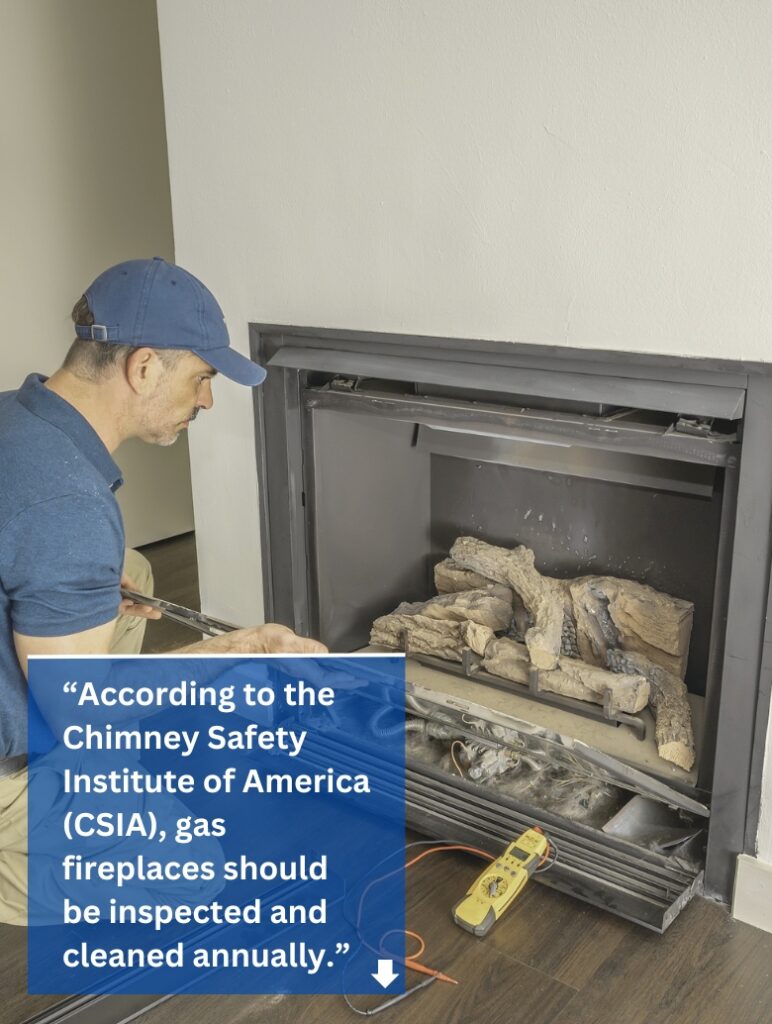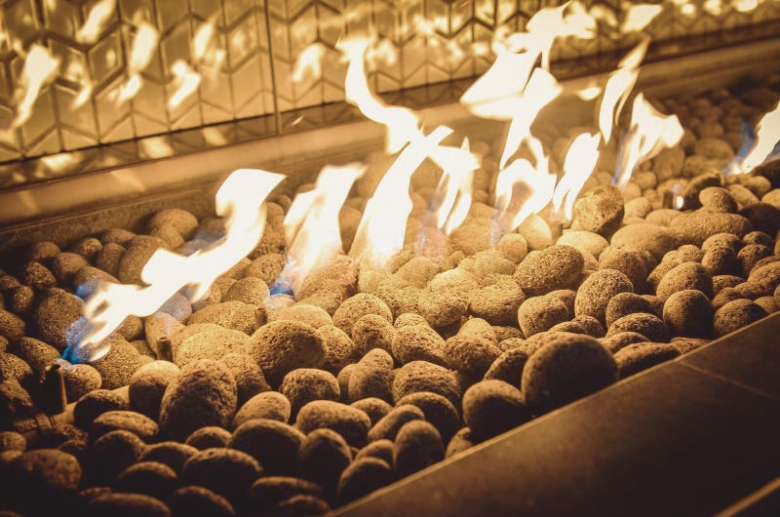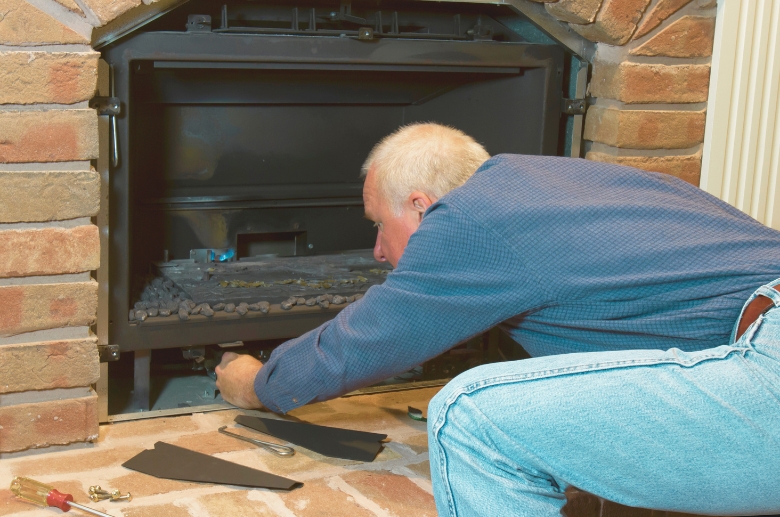There’s nothing like cozying up to a crackling fireplace as the chilly winds blow and the evenings grow darker. The warmth, the ambiance, the comforting glow – it’s a scene that’s been etched into our hearts and homes for centuries.
But when it comes to gas fireplaces, there’s a common misconception that they’re maintenance-free. After all, they’re not like their wood-burning counterparts, leaving behind a trail of ashes and soot.
While it’s true that gas fireplaces don’t produce the same mess as wood-burning ones, they do require regular attention to ensure their safety and efficiency. And the most crucial aspect of this upkeep is the chimney inspection.
In this in-depth guide, we’ll highlight the importance of a chimney inspection for gas fireplace, explore the signs indicating your chimney may need attention, and provide insights into the inspection process.
How Often Does a Gas Fireplace Chimney Need to Be Cleaned

According to the Chimney Safety Institute of America (CSIA), gas fireplaces should be inspected and cleaned annually. While gas appliances produce fewer creosote deposits than wood-burning ones, debris like bird nests and other blockages can still occur, necessitating regular maintenance.
It is also important to consider professional inspections, mainly because gas appliances can malfunction or vent improperly, leading to potential hazards, such as carbon monoxide leaks.
A thorough chimney inspection checklist helps professionals identify and address these issues proactively, ensuring the safety and efficiency of your fireplace.
——
Do You Need to Hire Chimney & Fireplace Expert?
Get free quotes from qualified experts near you. No commitment required!
——
Signs That Your Gas Fireplace Needs Inspection
As discussed, regular chimney inspection is essential to identify potential issues before they escalate.
So, here are signs indicating your gas fireplace needs inspection.
1. Difficulty in Starting the Fireplace
Difficulty in starting a fireplace can be attributed to various factors, with some of the common causes including issues with the ignition system, gas supply problems, or faults within the fireplace components.
The ignition system, which may include a pilot light or electronic igniter, can malfunction over time due to wear and tear, dirt accumulation, or electrical issues.
Gas supply problems are another frequent culprit. Insufficient gas pressure, a closed gas valve, or a blockage in the gas line can impede the flow of gas to the fireplace, preventing proper ignition. It’s essential to ensure that the gas supply is adequate and free from any obstructions.
Additionally, problems with components such as thermocouples, gas valves, or control modules can contribute to ignition issues. A thorough chimney inspection is crucial to identify and address these issues, ensuring the fireplace operates safely and efficiently.
2. Unpleasant Odors Coming from the Fireplace
Unpleasant odors emanating from the fireplace is a clear sign that immediate inspection is needed. A good example of this is sulfur, which smells like rotten eggs. Gas fireplaces should not produce foul smells.
If they do, it could indicate a gas leak or the presence of combustion byproducts. A comprehensive inspection will help pinpoint the source and ensure a safe operating environment.
3. Soot Buildup Around the Fireplace
While a minimal amount of soot is considered normal, an excessive accumulation is indicative of potential problems such as incomplete combustion or issues with ventilation.
Incomplete combustion occurs when the gas does not burn completely, leading to the production of soot particles. Ventilation problems may restrict the proper flow of air, affecting the combustion process and contributing to the buildup of soot.
4. Yellow Flames Instead of Blue

Keep an eye on the color of the flames. Normally, gas fireplaces should have blue flames. If you notice yellow flames instead, it may indicate incomplete combustion or the presence of impurities.
This affects the fireplace’s efficiency and poses potential safety risks. An inspection will also help diagnose and address this issue promptly.
The Chimney Inspection Process for Gas Fireplaces
The chimney inspection process for gas fireplaces involves a comprehensive assessment of key components to identify any potential issues and ensure optimal performance.
Chimney Inspection for Gas Fireplace Preparation
Before conducting a chimney inspection for gas fireplaces, it is crucial to undertake thorough pre-inspection preparation. Begin by clearing the area around the fireplace to ensure a safe and unobstructed workspace.
Remove any furniture, decorations, or objects that may hinder the inspection process. Additionally, ensure accessibility to all parts of the chimney by removing any barriers or obstacles.
Step 1. Visual Inspection of the Fireplace and Chimney

The initial step in gas fireplace chimney inspection involves a thorough visual examination of the fireplace and chimney components. This includes assessing the firebox, checking for any signs of corrosion or damage, inspecting the flue liner, and ensuring the damper is functioning properly.
Attention is also given to the exterior, looking for cracks or deterioration in the chimney structure.
Step 2. Inspection of the Venting System
To ensure proper airflow, it is essential to inspect the ventilation pathways for any obstructions or blockages that may impede the smooth passage of exhaust gases.
Additionally, checking the integrity of seals and connections in the venting system is crucial to prevent any leaks that could compromise the efficiency of the fireplace.
The inspection also includes checking for ventilation efficiency and ensuring that the gases produced during combustion are effectively vented outside. To check ventilation efficiency, one can perform a visual inspection of the venting components, ensuring that there are no blockages, debris, or signs of damage that might impede airflow.
Additionally, using specialized tools like a draft gauge can help measure the draft strength, providing valuable information about the effectiveness of the ventilation system.
Step 3. Gas Component Inspection
Thoroughly examining gas components is a crucial point on the chimney inspection checklist for gas fireplaces. This involves inspecting gas valves, pilot lights, and burners to ensure they function properly.
Special attention is given to detecting gas leaks and promptly addressing operational issues. This meticulous inspection ensures the safe and efficient operation of the gas fireplace, providing homeowners with peace of mind regarding their heating appliance.
Step 4. Safety Checks
Carbon monoxide and leak testing is a critical step here, which involves assessing carbon monoxide levels within the system. To assess carbon monoxide levels in a system, you can utilize carbon monoxide detectors or portable carbon monoxide meters.
These devices measure the concentration of CO in the air and indicate potential leaks. Additionally, professional inspections conducted by qualified technicians can provide comprehensive assessments of CO levels and identify potential sources of leaks.
Step 5. Inspect The Glass Doors and Logs
Over time, soot and residue can accumulate, diminishing the aesthetic appeal and hindering the view of the flames through the glass door. Regular cleaning enhances the fireplace’s visual appeal and promotes safety by preventing potential blockages.
Using specialized glass cleaners for the doors and a gentle brush for the logs is recommended to maintain the efficiency of the gas fireplace. This simple yet vital step contributes to a safer and more enjoyable experience.
Step 6. Post-Inspection Procedures
After thoroughly inspecting gas fireplaces, following a comprehensive post-inspection process is crucial. This involves providing a detailed report of findings to the homeowner or property manager, highlighting any issues discovered during the inspection.
Additionally, the inspector should advise on necessary repairs or cleaning tasks based on the identified issues. Providing clear recommendations for repairs or ongoing maintenance ensures the safe and efficient operation of the gas fireplace.
This post-inspection communication plays a vital role in keeping the fireplace in optimal condition and addressing potential safety concerns promptly.
——
Do You Need to Hire Chimney & Fireplace Expert?
Get free quotes from qualified experts near you. No commitment required!
——
The Importance of Hiring a Professional Chimney Sweep for Inspection

Hiring a professional chimney sweep for inspection matters, as they have the specialized skills and expertise required. Chimney sweeps possess in-depth knowledge of chimney construction, ventilation systems, and potential hazards associated with fireplaces.
They are trained to identify creosote buildup, blockages, and structural damage that could lead to chimney fires or carbon monoxide leaks.
The skills of a professional chimney sweep go beyond basic cleaning; they include assessing the condition of the chimney liner, flue, and masonry. These experts can identify issues invisible to the untrained eye, ensuring the chimney functions safely and efficiently.
Their knowledge of local building codes and regulations also ensures compliance, contributing to the home’s overall safety.
The Dangers of DIY Inspections
DIY inspections, on the other hand, pose significant dangers. Individuals without the necessary expertise may overlook critical issues, leading to potential fire hazards or exposure to harmful gases.
A study by the National Fire Protection Association (NFPA) highlights that many home heating fires result from failing to clean chimneys and vents properly.
Hiring a professional chimney sweep ensures a comprehensive inspection, as their skills and expertise contribute to the safety and efficiency of the entire heating system. Relying on DIY inspections may compromise safety and increase the risk of fire-related incidents.
The Benefits of Regular Gas Fireplace Inspection
Regular gas fireplace inspection ensures both safety and optimal performance. These inspections help identify and address potential issues such as gas leaks, faulty ignition systems, or blocked vents.
So, here are the benefits that come with adhering to a consistent inspection schedule.
Improved Energy Efficiency
Regular gas fireplace inspections ensure that the system is operating at peak efficiency. This not only helps in maximizing heat output but also contributes to lower energy consumption, reducing utility bills.
Efficient combustion ensures the fuel is utilized effectively, making the fireplace an eco-friendly heating option.
Reduced Risk of Carbon Monoxide Poisoning
Routine inspections are crucial for detecting and addressing potential issues that may lead to carbon monoxide leaks.
From checking ventilation to examining the burner and flue, inspections mitigate the risk of harmful gas leaks. This preventive measure is essential for the safety of occupants.
Improved Fireplace Performance and Longevity
Regular inspections identify and address issues that may hinder the fireplace’s performance. This includes cleaning and maintenance tasks that enhance overall functionality.
Gas Fireplace Inspection Cost
On average, the cost of a gas fireplace inspection typically ranges from $100 to $300. However, a gas fireplace inspection cost can vary depending on several factors.
One significant factor is the complexity of the fireplace system. Fireplaces with intricate designs or additional features may require more time and expertise to inspect, resulting in a higher cost.
Another consideration is the location and accessibility of the fireplace. The cost may increase if the fireplace is in a hard-to-reach area or requires special inspection equipment.
The age and condition of the gas fireplace also play a role in determining the inspection cost. Older fireplaces or those with a history of issues may require a more thorough examination, potentially raising the overall price.
Additionally, the qualifications and reputation of the inspection professional can influence the price. Experienced and certified technicians may charge higher fees for their expertise. But it’s all worth considering the dangers they eradicate with their services.
Conclusion
Prioritizing a regular chimney inspection for gas fireplace is paramount for homeowners. A thorough inspection ensures that potential hazards, such as blockages or gas leaks, are identified and rectified promptly, preventing accidents and ensuring the well-being of occupants.
The efficiency of the gas fireplace is also closely tied to its condition, and regular check-ups can optimize its performance, saving on energy costs. Longevity is another critical aspect, as timely inspections can prevent minor issues from escalating into major, costly repairs.
We encourage you to enlist our expertise for a comprehensive examination for a professional chimney inspection. Our knowledge and experience in identifying and addressing potential problems make us indispensable partners in maintaining a safe, efficient, long-lasting gas fireplace system.
Schedule a chimney inspection today to safeguard your home and family.






